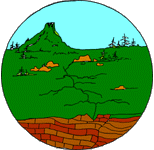|
SCIENCE STANDARDS
1. Students should be able to
distinguish several different volcanic rocks. They should be able to
conclude that volcanoes produce different types of rocks that reflect
the type of volcanic eruption that produced them.
2. Students should have developed
observational skills to distinguish different types of rocks.
3. Students
should begin to develop an understanding that earthquakes and volcanoes
are related.
4. Students should be able to
conclude that stress within the outer surface of the Earth causes the
Earth to move, hence creating earthquakes.
5. Students should be able to
demonstrate different types of motion that can create stress on the
outer surface of the Earth. They should demonstrate diverging,
converging and transform motion.
6. Students should be able to
distinguish the ability of some substances to resist stress, while
distinguishing some substance to crumble under stress.
7. Students should realize that
volcanoes can be a hazard to humans, property, and wildlife.
8. Students should be able to visualize that
volcanic disasters have occurred through historical times.
OVERVIEW OF THIRD GRADE
VOLCANOES
WEEK 1.
PRE: Explaining why there are many types of volcanic rocks.
LAB: Comparing rocks from different volcanoes.
POST: Learning that volcanoes produce different types of rocks.
EARTHQUAKES
WEEK 2.
PRE: Discovering that earthquakes produce energy.
LAB: Observing different energy experiments.
POST: Learning that pressure inside the Earth causes earthquakes.
PLATE TECTONICS
WEEK 3.
|PRE: Dividing the earth into
layers.
LAB: Discovering how the earth's crust creates plates.
POST: Explaining how plates have moved through time.
HAZARDS
WEEK 4.
PRE: Discussing different
volcanic hazards.
LAB: Exploring different types of volcanoes during an eruption.
POST: Learning about historical eruptions.
|

 Plate
Tectonic
Plate
Tectonic